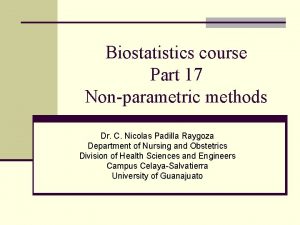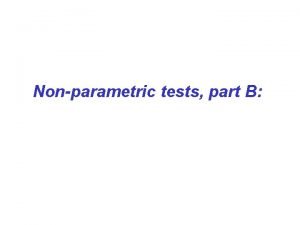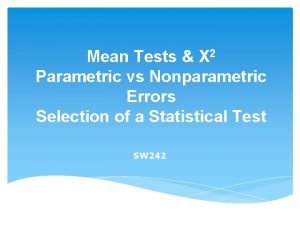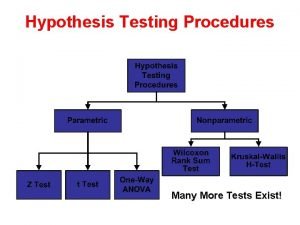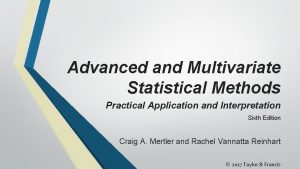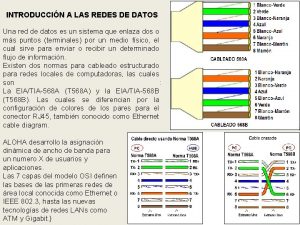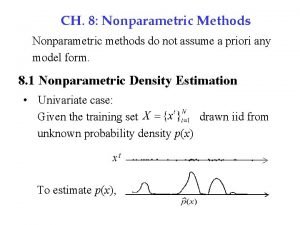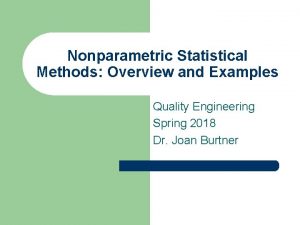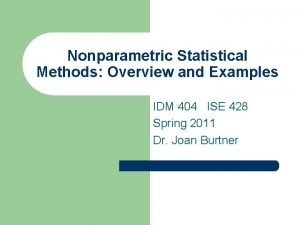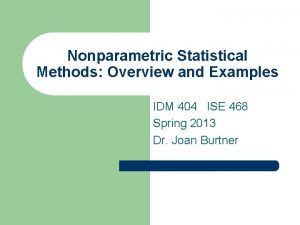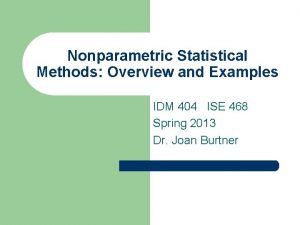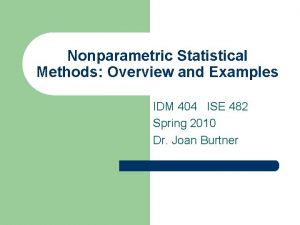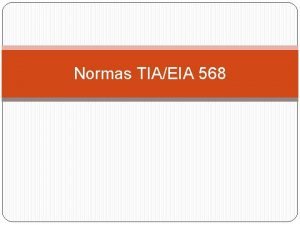Nonparametric Statistical Methods Overview and Examples ETM 568










- Slides: 10

Nonparametric Statistical Methods: Overview and Examples ETM 568 ISE 468 Spring 2015 Dr. Joan Burtner

Four Levels of Data l Nominal Ø Ø l Categorical (Qualitative): Distinct Categories North, South, East, West Bldg. 1, Bldg. 2, Bldg. 7 Ordinal Ø Ø Ø Categorical (Qualitative): Characteristics that possess a logical order 20/20, 20/30, 20/40 Small, Medium, Large H, M, L Special cases § Likert Scales (1 2 3 4 5) or (1 2 3 4 5 6 7 8 9 10) § Discrete counted variables (number of calls, number of children, particle counts) l Interval Ø Ø Ø l Continuous (Quantitative): value that can be measured Differences between intervals have true meaning No true zero Scale Ø Ø Continuous (Quantitative): value that can be measured True zero 2015 Presented by Dr. Joan Burtner Slide 2

Parametric Hypothesis Tests l l Assumption of a known distribution, typically the normal distribution Examples Ø Ø Ø Single sample T-tests and Z-tests Two-sample T-tests and Z-tests Single-factor ANOVA Two-factor ANOVA Multi-factor ANOVA Factorial designs 2015 Presented by Dr. Joan Burtner Slide 3

Non-parametric Hypothesis Tests l l l No assumption of an underlying normal distribution in the population Other assumptions apply (eg. level of measurement) Examples (Since names vary by text and software package, you must look at calculation of test statistic and assumptions) Ø Ø Ø Ø Mann-Whitney Rank-Sum Signed Rank Kruskal-Wallis Sign Mood’s Median Friedman Median Test 2015 Presented by Dr. Joan Burtner Slide 4

Minitab: Stat Menus l Stat/Non-parametric Ø Ø l l Stat/Multivariate and Stat/DOE Stat/Tables Ø Ø l l l Choose from seven non-parametric tests Names may be different from standard statistics texts One-way and Two-way Chi-Square Tests Not typically included in discussions of non-parametric statistical methods Stat/Basic Statistics Stat/ANOVA Stat/Regression 2015 Presented by Dr. Joan Burtner Slide 5

Minitab: 1 -Sample Sign Test l l Stat > Nonparametrics > 1 -Sample Sign You can perform a 1 -sample sign test of the median or calculate the corresponding point estimate and confidence interval. For the one-sample sign test, the hypotheses are H 0: median = hypothesized median versus H 1: median ≠ hypothesized median Use the sign test as a nonparametric alternative to 1 sample Z-tests and to 1 -sample t-tests , which use the mean rather than the median. 2015 Presented by Dr. Joan Burtner Slide 6

Minitab: 1 -Sample Wilcoxon l l Stat > Nonparametrics > 1 -Sample Wilcoxon You can perform a 1 -sample Wilcoxon signed rank test of the median or calculate the corresponding point estimate and confidence interval. The Wilcoxon signed rank test hypotheses are H 0: median = hypothesized median versus H 1: median ≠ hypothesized median An assumption for the one-sample Wilcoxon test and confidence interval is that the data are a random sample from a continuous, symmetric population. 2015 Presented by Dr. Joan Burtner Slide 7

Minitab: Mann-Whitney Test l l Stat > Nonparametrics > Mann-Whitney You can perform a 2 -sample rank test (also called the Mann. Whitney test, or the two-sample Wilcoxon rank sum test) of the equality of two population medians, and calculate the corresponding point estimate and confidence interval. The hypotheses are H 0: 1 = 2 versus H 1: 1 ≠ 2, where is the population median. An assumption for the Mann-Whitney test is that the data are independent random samples from two populations that have the same shape and whose variances are equal and a scale that is continuous or ordinal (possesses natural ordering) if discrete. 2015 Presented by Dr. Joan Burtner Slide 8

Minitab: Kruskal-Wallis Test l l l Stat > Nonparametrics > Kruskal-Wallis You can perform a Kruskal-Wallis test of the equality of medians for two or more populations. This test is a generalization of the procedure used by the Mann. Whitney test and, like Mood's Median test, offers a nonparametric alternative to the one-way analysis of variance. The Kruskal-Wallis hypotheses are: H 0: the population medians are all equal versus H 1: the population medians are not all equal An assumption for this test is that the samples from the different populations are independent random samples from continuous distributions, with the distributions having the same shape. 2015 Presented by Dr. Joan Burtner Slide 9

Minitab: Friedman test l l l Stat > Nonparametrics > Friedman test is a nonparametric analysis of a randomized block experiment, and thus provides an alternative to the Two-way analysis of variance. (according to Minitab) The hypotheses are: Ø Ø l H 0: all treatment effects are zero versus H 1: not all treatment effects are zero Randomized block experiments are a generalization of paired experiments, and the Friedman test is a generalization of the paired sign test. Additivity (fit is sum of treatment and block effect) is not required for the test, but is required for the estimate of the treatment effects. 2015 Presented by Dr. Joan Burtner Slide 10
